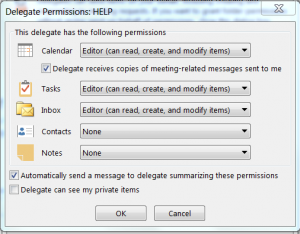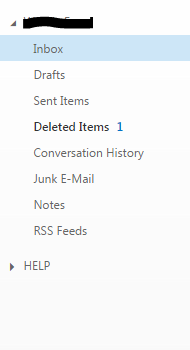Email Account Types
Delegate Email Access
Delegate Access is an Outlook feature that enables one person to act on behalf of another Outlook user. The most common scenario in which this feature is used is a manager and his or her assistant. The assistant might be responsible for maintaining the manager's schedule, such as creating and responding to meeting requests. Some assistants might also monitor a manager's Inbox and send email on behalf of the manager.
Outlook 2013
Add another person's mailbox to your profile

(Note: The person who is sharing a mailbox must grant you Folder visible permission on the root folder of the Exchange mailbox.)
Folder Permission
- Instructions for granting Folder visible permission (Manager)
- Right-click the root folder of the Exchange mailbox, and then click Folder Permissions.
- Click the name of the delegate
- Under Permissions, under Other, select the Folder Visible check box
- Click OK
- As the delegate, do the following in Outlook
- Click File> Account Settings> Account Settings
- On the Email tab, in the list, click the Exchange account type, then click Change and then click More Settings.
- On the Advanced tab, under Open these additional mailboxes, click Add, and then enter the mailbox name of the person whose mailbox that you want to add to your user profile. If you do not know the mailbox name, ask the person who granted you Delegate Access permissions.
Send or respond to meeting requests for another person
Give delegate access

To give the delegate sufficient permissions to accept meeting requests for the manager, the manager must do the following:
- Click File > Account Settings > Delegate Access.
- Click Add, then type or select, the delegate’s name, and then click Add.
- Do one of the following:
- In the Delegate Permissions dialog box, give the delegate Editor (can read, create, and change items)permissions in the manager's Calendar folder.
- Click OK to close the Delegate Permissions dialog box, then select the check box at either My delegates only, but send a copy of meeting requests and responses to me or My delegates only.
To respond to meeting requests
- Open the other person's Inbox if his or her meeting requests are not sent to you directly.
- Open the meeting request.
- Click Accept, Tentative, or Decline.
To send a meeting request
- Open the other person's calendar.
- On the Home tab, in the New group, click New Meeting.
- Enter the attendees, subject, location, and start and end times as you ordinarily do
Create or reply to an email message on behalf of another person
Note: emails appear in the senders sent mail, not the person that it was sent on behalf of
Send on behalf of

- In Mail, click Home > New Email.
- On the Options tab, in the Show Fields group, click From.
- In the From box, type the name of the person on whose behalf you are sending the message.
- To select the name from a list in the Address Book, click From.
- Add recipients, a subject, and the contents of the message as you typically do.
Reply to an email on behalf of
- In the other person's mailbox, select the message that you want to reply to on behalf of your manager.
- Click Home (If you have opened the message, click Message), and then click Reply, Reply All or Forward.
- On the Options tab, in the Show Fields group, click From.
- In the From box, type your manager's name. To select the name from a list in the Address Book, click From. If you don’t see the From button and box, click Options > From.
- Add recipients, a subject, and the contents of the message as you typically do.
Outlook Web App
Delegate functionality is not enabled in OWA, it is a Outlook client feature only
Shared mailboxes are accessed in the Outlook 2013 client through folders within your personal account. They appear in the area beneath the list of cabinet folders, and can be expanded to reveal account contents by clicking the triangle to the left of the account name.
Full access users have shared mailbox account folders automatically show up in their Outlook 2013 client, whereas others with whom full access users have granted folder access need to follow the below directions to add them to their account.
Outlook 2013
- Click File, the Account Settings drop-down menu, and choose Account Settings.
- Under the "E-mail" tab, choose your account, and then click Change.
- Click More Settings..., click the Advanced tab, and then click Add.
- Type the name of the shared mailbox, and then click OK.
- Click OK, Next, and Finish.
- Close the Accounts settings window, and the shared mailbox account will become available under your folder list on the left side of the screen.
Outlook Web App

shared mailboxes will automatically appear in OWA